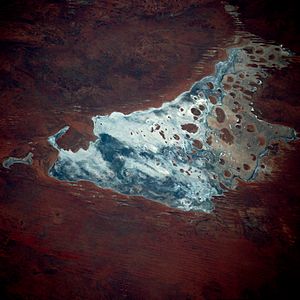Linda Syddick Napaltjarri facts for kids
Quick facts for kids
Linda Syddick Napaltjarri
|
|
|---|---|
| Born | c.1937 Wilkinkarra (Lake Mackay), Western Australia
|
| Known for | Painting |
| Awards | Finalist, National Aboriginal & Torres Strait Islander Art Award: 1995, 2006, 2008, 2009 Finalist, Blake Prize: 1990 |
Linda Yunkata Syddick Napaltjarri, born around 1937, is an amazing Indigenous artist from Australia's Western Desert. She speaks Pintupi and Pitjantjatjara languages. Her stepfather, Shorty Lungkarta Tjungarrayi, was also an artist and greatly influenced her work.
Linda Syddick started painting in the early 1990s. Her art is special because it mixes traditional Aboriginal ideas with Christian themes. She has been a finalist many times in important art awards, like the National Aboriginal & Torres Strait Islander Art Award and the Blake Prize, which is for religious art. Her paintings are displayed in major galleries, including the National Gallery of Australia. A famous artist named Robert Hannaford even painted her portrait, which was a finalist in the Archibald Prize in 1992.
Contents
About Linda Syddick's Life
The exact year Linda Syddick was born is not certain, but it was around 1937 or 1941. This is common for Indigenous Australians, as they often track time differently. She was born near a place called Wilkinkarra, also known as Lake Mackay, in Western Australia. This area is northeast of Kiwirrkurra and northwest of Kintore.
Understanding Skin Names
'Napaltjarri' is a "skin name," which is a special name used by central Australian Indigenous people. These names help show family connections and who people can marry. They are not like European last names. So, 'Linda Syddick' is her unique part of the name. She has also been called Tjungkaya Napaltjarri, but she is not the artist Tjunkiya Napaltjarri.
Her Family and Early Years
Linda Syddick's parents were Wanala or Napulu Nangala and Rintja Tjungurrayi. Sadly, her father Rintja passed away when she was very young. In 1943, her mother moved to Kintore. Her stepfather, Shorty Lungkarta Tjungarrayi, was a big inspiration for her painting. Linda married Musty Siddick and they had two children, Ruby and Irene. In the 1970s, they lived in a Pintupi community called Yayayi. After Musty passed away, she married again.
Linda Syddick is also known for being a model for paintings. She was the subject of a portrait by Robert Hannaford in 2002. This painting was a finalist in the Archibald Prize, Australia's top portrait competition.
Linda Syddick's Art
How Indigenous Art Began
Modern Indigenous art in the Western Desert started in 1971. Indigenous men at Papunya began painting with help from a teacher named Geoffrey Bardon. They used acrylic paints to create designs that looked like traditional body paint and ground art. This art style quickly spread across central Australia. By the 1980s and 1990s, this art was shown all over the world.
At first, only men painted. But many women wanted to join in too. In the 1990s, a large number of Indigenous women started creating paintings. In communities like Kintore, Yuendumu, and Balgo, artists began making artworks specifically to show and sell.
Her Artistic Journey
Linda Syddick was painting by 1991. Her artworks were first shown in a gallery in Alice Springs, Northern Territory. Her paintings, like A nest of crosses, gladly borne, mix traditional Indigenous painting styles with Christian images and ideas. For example, she painted Eucharist, which explored Christian influences in Indigenous culture. Another painting, ET: the bicycle ride, showed Hollywood influences.
Her interest in Christian symbols is clear in her work. Her painting The Eucharist was part of an exhibition in 2004 that looked at how Christianity came to Australia. Other paintings show her traditional homeland, like Tingari Men at Wilkingkarra (Lake Mackay). This painting was a finalist in the 2009 National Aboriginal & Torres Strait Islander Art Awards.
Artists from the Western Desert, like Linda Syddick, often paint figures from the Tingari cycle. These are stories about ancestral elders who traveled across vast lands in the Dreaming. They performed rituals and shaped the land.
In 1990, Linda Syddick went to Sydney to see her painting Ngkarte Dreaming in the Blake Prize exhibition. She was a finalist in this religious art competition three times before 1994. One of her paintings was also included in the Adelaide Biennial of Australian Art in 1998. She has been a finalist in the National Aboriginal & Torres Strait Islander Art Awards several times: in 1995, 2006 (with The Witch Doctor and the Windmill), 2008 (with Big rain at Walukurritje), and 2009 (with Tingari Men at Wilkingkarra (Lake Mackay)).
Linda Syddick's artworks are held in many important public collections. These include the National Gallery of Australia, the Art Gallery of New South Wales, and the Art Gallery of South Australia.
Where Her Art Is Kept
- Art Gallery of New South Wales
- Art Gallery of South Australia
- Artbank
- Auckland City Art Gallery
- Museum and Art Gallery of the Northern Territory
- National Gallery of Australia
- Kluge-Ruhe Aboriginal Art Collection of the University of Virginia
Awards and Recognition
- 2009 – Finalist, 26th National Aboriginal & Torres Strait Islander Art Award
- 2008 – Finalist, 25th National Aboriginal & Torres Strait Islander Art Award
- 2006 – Finalist, 23rd National Aboriginal & Torres Strait Islander Art Award
- 1995 – Finalist, 12th National Aboriginal & Torres Strait Islander Art Award


